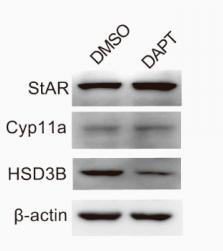HSD3B2 Antibody - #DF6639
| Product: | HSD3B2 Antibody |
| Catalog: | DF6639 |
| Description: | Rabbit polyclonal antibody to HSD3B2 |
| Application: | WB IHC IF/ICC |
| Cited expt.: | WB, IF/ICC |
| Reactivity: | Human, Mouse, Rat, Duck |
| Prediction: | Horse |
| Mol.Wt.: | 42kDa; 42kD(Calculated). |
| Uniprot: | P26439 |
| RRID: | AB_2838601 |
Related Downloads
Protocols
Product Info
*The optimal dilutions should be determined by the end user. For optimal experimental results, antibody reuse is not recommended.
*Tips:
WB: For western blot detection of denatured protein samples. IHC: For immunohistochemical detection of paraffin sections (IHC-p) or frozen sections (IHC-f) of tissue samples. IF/ICC: For immunofluorescence detection of cell samples. ELISA(peptide): For ELISA detection of antigenic peptide.
Cite Format: Affinity Biosciences Cat# DF6639, RRID:AB_2838601.
Fold/Unfold
3 beta HSD adrenal and gonadal type; 3 beta HSD II; 3 beta HSD type II; 3 beta hydroxy 5 ene steroid dehydrogenase; 3 beta hydroxy Delta(5) steroid dehydrogenase; 3 beta hydroxysteroid dehydrogenase/Delta 5-->4-isomerase type 2; 3 beta-hydroxysteroid dehydrogenase type II, delta 5-delta 4-isomerase type II, 3 beta-HSD type II; 3 beta-hydroxysteroid dehydrogenase/Delta 5-->4-isomerase type II; 3 beta-hydroxysteroid dehydrogenase/Delta 5-->4-isomerase type 2; 3-beta-HSD II; 3-beta-hydroxy-5-ene steroid dehydrogenase; 3-beta-hydroxy-Delta(5)-steroid dehydrogenase; 3BHS2_HUMAN; ADRENAL HYPERPLASIA II; beta-hydroxysteroid dehydrogenase/Delta 5-->4-isomerase type 2; delta 5 delta 4 isomerase type II; Delta-5-3-ketosteroid isomerase; HSD3B; HSD3B2; HSDB; HSDB3B; hydroxy delta 5 steroid dehydrogenase, 3 beta and steroid delta isomerase 2; Hydroxy-delta-5-steroid dehydrogenase, 3 beta- and steroid delta-isomerase 2; Progesterone reductase; SDR11E2; short chain dehydrogenase/reductase family 11E, member 2; Steroid Delta-isomerase;
Immunogens
A synthesized peptide derived from human HSD3B2, corresponding to a region within the internal amino acids.
- P26439 3BHS2_HUMAN:
- Protein BLAST With
- NCBI/
- ExPASy/
- Uniprot
MGWSCLVTGAGGLLGQRIVRLLVEEKELKEIRALDKAFRPELREEFSKLQNRTKLTVLEGDILDEPFLKRACQDVSVVIHTACIIDVFGVTHRESIMNVNVKGTQLLLEACVQASVPVFIYTSSIEVAGPNSYKEIIQNGHEEEPLENTWPTPYPYSKKLAEKAVLAANGWNLKNGDTLYTCALRPTYIYGEGGPFLSASINEALNNNGILSSVGKFSTVNPVYVGNVAWAHILALRALRDPKKAPSVRGQFYYISDDTPHQSYDNLNYILSKEFGLRLDSRWSLPLTLMYWIGFLLEVVSFLLSPIYSYQPPFNRHTVTLSNSVFTFSYKKAQRDLAYKPLYSWEEAKQKTVEWVGSLVDRHKETLKSKTQ
Predictions
Score>80(red) has high confidence and is suggested to be used for WB detection. *The prediction model is mainly based on the alignment of immunogen sequences, the results are for reference only, not as the basis of quality assurance.
High(score>80) Medium(80>score>50) Low(score<50) No confidence
Research Backgrounds
3-beta-HSD is a bifunctional enzyme, that catalyzes the oxidative conversion of Delta(5)-ene-3-beta-hydroxy steroid, and the oxidative conversion of ketosteroids. The 3-beta-HSD enzymatic system plays a crucial role in the biosynthesis of all classes of hormonal steroids.
Endoplasmic reticulum membrane>Single-pass membrane protein. Mitochondrion membrane>Single-pass membrane protein.
Expressed in adrenal gland, testis and ovary.
Belongs to the 3-beta-HSD family.
Research Fields
· Metabolism > Lipid metabolism > Steroid hormone biosynthesis.
· Metabolism > Global and overview maps > Metabolic pathways.
· Organismal Systems > Endocrine system > Ovarian steroidogenesis.
· Organismal Systems > Endocrine system > Aldosterone synthesis and secretion.
References
Application: IF/ICC Species: Mouse Sample:
Application: WB Species: Shan-maducks Sample: ovarian
Application: IF/ICC Species: Rat Sample:
Application: WB Species: porcine Sample: pGCs
Application: WB Species: Mouse Sample:
Restrictive clause
Affinity Biosciences tests all products strictly. Citations are provided as a resource for additional applications that have not been validated by Affinity Biosciences. Please choose the appropriate format for each application and consult Materials and Methods sections for additional details about the use of any product in these publications.
For Research Use Only.
Not for use in diagnostic or therapeutic procedures. Not for resale. Not for distribution without written consent. Affinity Biosciences will not be held responsible for patent infringement or other violations that may occur with the use of our products. Affinity Biosciences, Affinity Biosciences Logo and all other trademarks are the property of Affinity Biosciences LTD.













